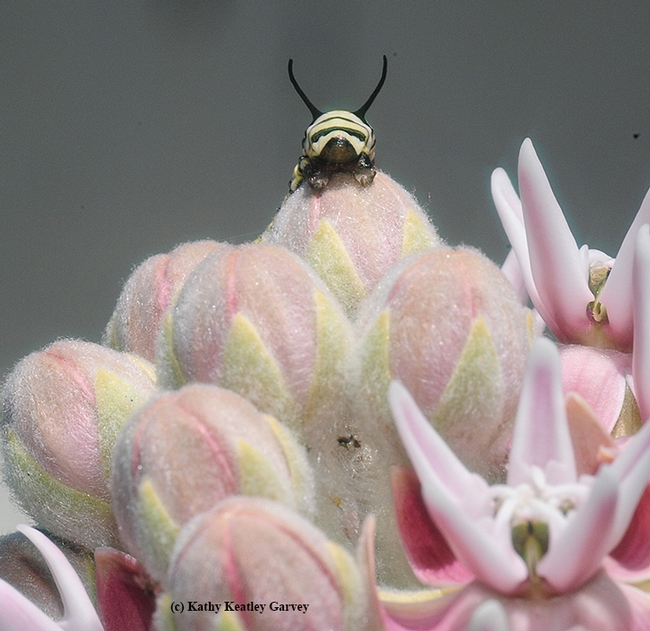Sometimes caregivers, including grandparents, aunts, uncles, cousins and neighbors, take photos of babies to show "proof of life." They post them for the parents to see, admire and confirm.
It's delightful to see images of your offspring while you're on vacation, on a business trip, or just out and about.
Same with monarch caterpillars. "Monarch Moms" and "Monarch Dads" take "proof-of-life" photos.
Often we'll see a hungry monarch caterpillar chomping and chewing and gorging on milkweed. It's a pretty sight, these chunky white caterpillars banded in yellow and black doing what they do best--eating. Some day they'll form a "J" and then a jade-green chrysalis rimmed with gold. And then--voila!--an adult monarch will eclose.
Some day, but maybe not.
A predator may nail them.
We recently noticed a Missing-in-Action caterpillar from our showy milkweed, Asciepias speciosa, and a quite contented Western scrub jay looking like the cat that ate the canary, or the scrub jay that ate the 'cat. Note that the jays nest in our trees, and to nourish them, we feed them seeds year-around in the birdfeeder.
The birdfeeder, however, happens to be located right next to the 8-foot showy milkweed where monarchs lay their eggs.
Jays apparently like a varied diet. Like a fat juicy worm (to them). Yum? Not yum. It does not taste good. Species in the genus Asclepias produce the toxic cardiac glycosides and this helps protect the caterpillars from predators. Although they don't taste good, they will still eat a few.
The photos below are proof of life of one hungry, thriving caterpillar. The next day? Gone. It became a bird's dinner.
But not its sibling caterpillar. We rescued it and fed it and watched it form a chrysalis. Soon an adult monarch butterfly wlll eclose. This one will be "proof of life."
Attached Images:

A monarch caterpillar summits a milkweed, Asciepias speciosa. (Photo by Kathy Keatley Garvey)

It's dinner time! It's always dinner time for a monarch caterpillar. It later became dinner for a bird. (Photo by Kathy Keatley Garvey)

A monarch caterpillar surrounds its food. (Photo by Kathy Keatley Garvey)